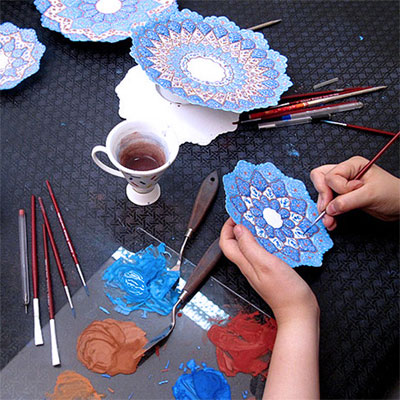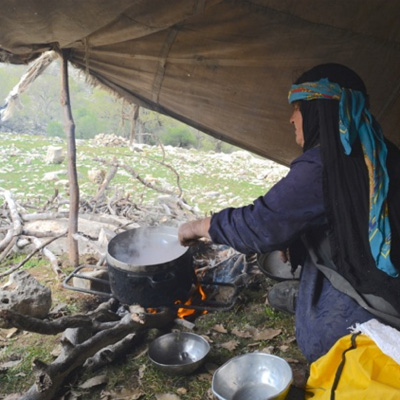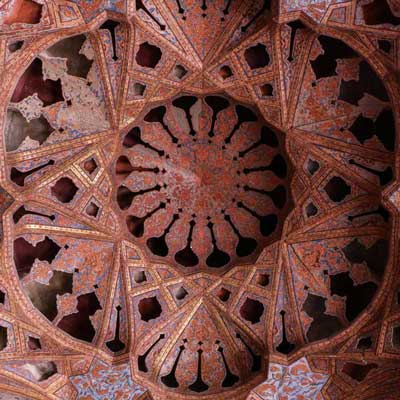Accommodation
9 nights in 3-4-5-star double room, 2 nights in the guesthouse, 2 nights in the local house, and 1 night in a nomadic tent
Day 1: Tehran - Ghazvin - Alamut
Upon your arrival in Imam Khomeini International Airport, Shakiba’s representative awaits to welcome you. Then transfer to the City of Qazvin. After a short rest and serving your breakfast at Guest House, we drive towards the Alamut area. Continue driving up to Alborz Mountains, we pass some villages and stop at Canyons of Andej village where having a cup of coffee or tea makes you fresh. The canyons in the valley of Assassins is a must-see attraction. You will find a twisted form of sandstone rock material in this zone of the valley. There is not so much walking, but we promise you will like the scenery! Be ready for light trekking that takes us up to Alamut Castle. There would be a maximum of two hours of walking/hiking in the plan. Alamut Castle (Hassan-i Sabbah Castle) has over 600 steps from hiking. In the end, we will have time to socialize with locals before a traditional dinner.
Overnight: Alamut (Local House), Meals: B, L, D
Day 2: Alamut - Garmaroud - Dinehroud
In the morning we start of Trekking from Garmaroud Village, we will transfer to this village; it is about 15 kilometers far from the T-junction of the main road to Alamut castle. After that, we will trek approximately until evening. Garmaroud can be the most walker-friendly one in the area. You may pass some small canyons or may walk a little on the bed of the alive rivers, then be prepared for wet shoes!
More details
The regular one-day trekking plan is from Garmaroud to Narmilat (based on the time availability of the tourists and the weather conditions). This walking is not only on the uneven surface, so be prepared with your proper walking shoes and possibly walking sticks. You will pass small rivers, hike up and descend from the mountains and hills. If you are here in the valley on the season March – June, you will have the beautiful views of the snow-capped mountains. Trekking allows you to be in contact with the pure local lifestyle.
Overnight: Dinehroud (Local House), Meals: B, L, D
Day 3: Dinehroud - Tonekabon - Ramsar
After having a local Breakfast in Dinehroud, we start to Trek in the heart of the natures and mountains and the villages around. The view is amazing in early spring in this zone, but the weather may change within an hour from being full sunny to completely foggy or sometimes rainy. However, as long as one of our local mountain guides is accompanying you on this trip, there is nothing to be worried about!
Since the weather is always good in simple words in the summertime in this area, if you pass Pichebon or have hiked around this village, you will pass by some herds of sheep (maybe belonging to nomads in the valley or the villagers from close by communities) and many beehives. This road ends up and takes you in the Caspian Sea at the town of Tonekabon when you drive about and pass Maraan, Yuj and some other villages.
Overnight: Ramsar, Meals: B, L, D
Day 4: Ramsar - Masuleh - Roudkhan Castle - Anzali
Enjoy the scenic driving alongside the Caspian Sea and drive to Masuleh. Masuleh architecture is extraordinary, and courtyards and roofs both serve as pedestrian areas similar to the streets. However, the small streets and many stairs also wouldn’t make it possible for vehicles to enter. This makes the town enjoyable to explore on foot and allows meeting and enjoying the hospitality that Iran is renowned for. After visiting the historic village of Masuleh, we’ll drive towards Fuman visiting the Rudkhan Castle. Construction of Rudkhan Castle dates back to the Sassanid era. In the 11th century, Hassan-i Sabbah and his followers used Rudkhan Castle as one of the assassin castles in Iran. The length of the wall around this castle is 1,500 meters, and you have to climb many steps to reach it. Then, we drive to Anzali via the Caspian Sea coastal-line town.
Overnight: Anzali, Meals: B, L, D
Day 5: Anzali - Astara - Heyran Valley - Ardebil - Sareyn
Today we’ll be driving to Sareyn. En route visiting Asalem to Talesh Roud. On the way to Asalem, you are going to experience untouched and pristine nature around Asalem Road. This road is one of the best scenic routes in Iran. You can see many beautiful landscapes on your way to Astara. Then, you will drive to Ardabil via Heyran pass. Heyran pass links Gilan and Ardabil provinces and has many scenic landscapes to photography. People believe that this pass was named Heyran as it is almost always shrouded in a cloud of mist, creating an astonishing view for onlookers. Heyran Road that leads to Sareyn and Ardebil. In Ardebil, you will visit one of the main sights in the city in northwest Iran, the shrine of Sheikh Safi al-Din Ardabili (World Heritage Site). He (died in 1334 AD) was the spiritual leader of Safavid kings. When traveling there, you really must try some of the traditional dishes, as there is an excellent variety of food, traditional desserts, and sweets, and the quality of their honey is renowned. In the evening we arrived at Sareyn. Sareyn is famous for its (“warm spas”). The springs are near the inactive volcano, mount Sabalan or Savalan (third highest peak in Iran) and its water contains Sulphur particles. You can use SPA and take a rest and relax.
Overnight: Sareyn, Meals: B, L, D
Day 6: Sareyn - Kandovan - Tabriz
Today, you’ll journey to Kandovan in the volcanic highlands of Mt. Sahand. About 60 km away from Tabriz lies Kandovan where exemplifies human-made cliff dwellings. It has a reputation of the rocky village which is still inhabited. Kandovan as troglodyte homes is similar to dwellings in the Turkish region of Cappadocia. In the evening we will drive to Tabriz.
Overnight: Tabriz, Meals: B, L, D
Day 7: Tabriz
After breakfast, start your city tour in Tabriz. You start your sightseeing by visiting Blue mosque (1465 AD) whose mosaic tiles invite you to deep thinking. Once the mosque was built, artists took a further 25 years to cover every surface with the blue majolica tiles and intricate calligraphy for which it was nicknamed (Lonely Planet). Once the mosque was built, artists took a further 25 years to cover every surface with the blue majolica tiles and intricate calligraphy for which it was nicknamed. The interior is also blue, and missing patterns have been laboriously painted onto many lower sections around the few remaining patches of original tiles. A smaller domed chamber away from the entrance once served as a private mosque for the Qareh Koyunlu shahs. However, as you stand before the north façade with much of its original tile work still intact, you’ll get a glimpse into the enduring artistic legacy of Iran’s ancient dynasties. Next door, at the Azerbaijan Museum, you’ll peruse a vast collection of archaeological artifacts spanning millennia of human history and culture in the region. You’ll also see the Arg-e Alishah, an imposing but unfinished 14th-century monument that later served as a military fortress during the Russo-Persian Wars of the 19th century. Afterward, you will visit the Grand Bazaar, the only bazaar on the UNESCO list of World Heritage Sites. It’s a wonderful place to chat with engaging merchants and browse for jewelry, carpets, and spices. However, with 4 miles of shops, you’ll also mingle with friendly residents who are here to shop for spices and other daily staples. End your day by visiting Shah Goli (El-Goli), a large park with an artificial lake in the middle. It is a perfect place for afternoon strolls.
Overnight: Shiraz, Meals: B, L, D
Day 8: Shiraz
After serving breakfast, your tour starts with a visit to the city of Shiraz. You start your sightseeing by visiting Nasir-al Mulk mosque whose pink arrays invite you to deep silence. The next site you are going to visit is Narenjestan Qavam, which was formerly an educational institute for the famous orientalist, Arthur Pope. Arthur Pope and his wife have used the place for doing researches and have changed it into a museum. In the evening, you will have a walking tour to see the exterior view of Karim Khan Citadel and go shopping in Vakil Bazaar. The evening is a good opportunity to be taken to Hafezieh (tomb of Hafez). The last one is Ali ibn Hamzeh Holly Shrine. The evening is at your leisure.
Overnight: Shiraz, Meals: B, L, D
Day 9: Shiraz - Kahkaran
Today, you will visit Ganbil Canyon. Ganbil is one of the most beautiful places in the Zagros Mountains in the south of Iran located about 130k from the northwest of Shiraz. Arrive at Kahkaran Village and start trekking. Stop to a nomad’s family for lunch; continue trekking to the canyon; Arrive at a nomad’s family around sunset; Spend the night with the nomad’s family.
Overnight: Kahkaran (Nomadic Tent), Meals: B, L, D
Day 10: Kahkaran - Persepolis - Yazd
After homemade breakfast, we drive to Persepolis and the Necropolis from a different way. Today you will see some parts of the rich history of Iran. Persepolis, be constructed in 5th century BC, is a beautiful architectural masterpiece that considered as a symbol of Achaemenid Empire. To continue your trip, you stop at Naqsh-e Rustam and visit four tombs of the ancient kings. After getting familiar with the majesty and glory of the Achaemenid Empire, you go to Yazd and on the way, you will have a stop to visit Abarkooh and Aghazade house. Unpredictable surprisingly historical House (Nearly 400 years old) where you can have a delicious dinner in front of a beautiful garden. The atmosphere is quiet, far from any stress. The windcatcher is unique. At night you will arrive at Yazd.
Overnight: Yazd, Meals: B, L, D
Day 11: Yazd - Ardakan
You leave your hotel in the morning to be transferred to the Zoroastrian Fire Temple and the Tower of Silence. Zoroaster was a pre-Islamic prophet in Iran who was famous for bringing peace and friendship. He had many supporters in the country, and there are still many Iranians who are following his verdicts. This Fire Temple is a place still active for praying, and it is regarded as the unique one in Iran. After your visit, you get amazed by another unique structure called Tower of Silence where Zoroastrians would leave dead bodies for excarnation. Yazd is a city incredibly famous for Henna. Thus, it is planned to visit a workshop in the town and learn how Henna is ready to be used in traditional Asian medication. It is also used in marriage and some ritual ceremonies. The evening is the time where you pass through the lanes of an old Quarter called Fahadan. On your way to a Baklava baking workshop (a kind of traditional sweet). Pass Amir Chaqmaq Square, and enjoy the evening view of the square and visiting Yazd Jameh Mosque, the first view that attracts you is the facade and the tall minarets of the mosque. You will take a walk in the area near the mosque and enjoy the antiques, which are in the nearby shops. In the evening we visit the Old Persian tradition of Zoorkhaneh, where men of all ages meet in old and hidden gyms to strengthen their bodies and minds. Accompanied by singing and drum beats, precise exercises are performed with high respect of each other and god. It is a unique and highly authentic local experience! Drive to Ardakan about. Your stay is at the Traditional old house in the heart of Ardakan’s historical places. You can go up to the roof and see Ardakan from above.
Overnight: Ardakan (Guest House), Meals: B
Day 12: Ardakan - Isfahan
Ardakan hosts the world’s largest one-sided wind tower. You explore the city of Ardakan with its amazing aqueduct (qanat). In this qanat, the youngest of Iran’s pitman is ready to familiarize you with the culture of the ancient people and the system of extracting water from the depths of the ground. Then you pass through the mud-brick lanes which have created one of the largest Iranian adobe structures. After that, we head out to Tahini (sesame paste known as Ardeh in Iran) workshop. The carpet museum is your next stop, and you will be taken to the dolls farm. After lunch, in the evening we drive toward Isfahan.
Overnight: Isfahan, Meals: B
Day 13: Isfahan
Today you will visit the city of Isfahan, As the 17th-century capital of the Safavid Empire. Isfahan was one of the world’s greatest cities – architecturally striking, wealthy beyond imagination, and politically powerful with Europeans, Ottomans, Indians, and Chinese coming to its court – the heart of a vast Persian Empire that stretched from the Euphrates River in present-day Iraq to the Oxus River in Afghanistan. Indeed, its grandeur inspired the rhyming proverb, “Isfahan Nesf-e Jahan” (Isfahan is Half the World). Capture the marvels of the Safavid dynasty, all in a single square, Naqsh-e Jahan Square. Once used as a polo field, Naqsh-e Jahan square is now a lively traditional bazaar. Marvel at Ali Qapu Palace with its unique features and mesmerizing view of the square from the top, you’ll marvel at its beautiful music rooms and the balconies where Safavid kings would sit to enjoy the polo matches unfolding in the square below. Soak up Islamic architecture in a magnificent Imam Mosque on one side and small but impressive Sheikh Lotfullah Mosque on the other side of the square.
Sip some tea and indulge yourself in an ethnic dish in a great place. Stroll in splendid Chehel Sotoun Palace with the gardens surrounding it. After lunch, the next is visiting with the Chehel Sotoun Palace (World Heritage Site). When you count its columns, you’ll get number twenty. Don’t be surprised. Certainly, ask your guide why does it call 40-columns-palace? The fabulous murals of this palace represent the wars and joys of the Safavid, Qajar kings and Afshar (18 century AD). This evening is your free time. Recommend you to take a stroll at Naqsh-e Jahan Square, and visit the Qeisariyeh Bazaar to spend a couple of hours there. You would get familiar with Iranian handicrafts, and it is worth shopping.
Overnight: Isfahan, Meals: B, L, D
Day 14: Isfahan - Tehran
Capture the picturesque beauty of the Jolfa Quarter. Armenian of Isfahan lives in this quarter that they’ve moved to Isfahan from Azerbaijan in the Safavid period. There are several churches in this quarter, which the Vank Cathedral is the largest one. A museum that will be seen in the cathedral can get familiar you with Armenian history of Isfahan. After lunch, you will enjoy the traditional Iranian music at the Music Museum and know about all the old and modern Iranian musical instruments, and also you will enjoy the live performance in this Museum. In the evening we drive to Tehran, International Airport for the flight back to Home.
Overnight: Waiting at the Airport, Meals: B, L, D
Day 15: Tehran
Departure
9 nights in 3-4-5-star double room, 2 nights in the guesthouse, 2 nights in the local house, and 1 night in a nomadic tent
Private Car (2 Pax), Van (3 – 9 Pax), Middle Bus (10 – 20 Pax), Domestic Flight
Airport – Hotel – Airport Transfer
All Meals and mineral water on this trip are included
Iran Visa (Reference Code)
All Entrance Fees Are Included
Professional Tour Guide
Free Wifi
Iranian SIM Card
Not Covered in the Tour Price
International Flights Are Not Included
Visa Stamp Fee, Tips & Portages Are Not Included

It’s the time to get familiar with Isfahan handicraft. Minakari is a miniature painting with azure color that has been suited to the brand of Isfahan “turquoise domes city.” Join us to see the art of locals.

Let’s go on an adventure! Spend the memorable nights with a nomad family while encountering their lifestyle and doing what they do every day like milking sheep and goats, shepherding, eating local foods and other fascinating activities of their life.

It is planned to visit a workshop in the city and learn how Henna is ready to be used in Asian traditional medicine. It is also used in marriage and some ritual ceremonies.

If you are thinking about Iranian music, we are here to help! Get ahead of the Music Museum and listen to the Iranian mystics music.
| Group Size (Pax) | DBL Room | SNGL Room | Date Available |
|---|---|---|---|
| 2 | June to August and December to mid-March | ||
| 4 | June to August and December to mid-March | ||
| 6-8 | June to August and December to mid-March | ||
| 10-12 | June to August and December to mid-March | ||
| 14-18 | June to August and December to mid-March | ||
| 20-24 | June to August and December to mid-March |